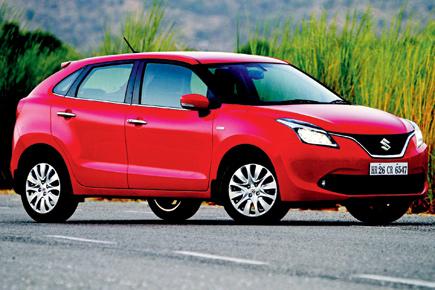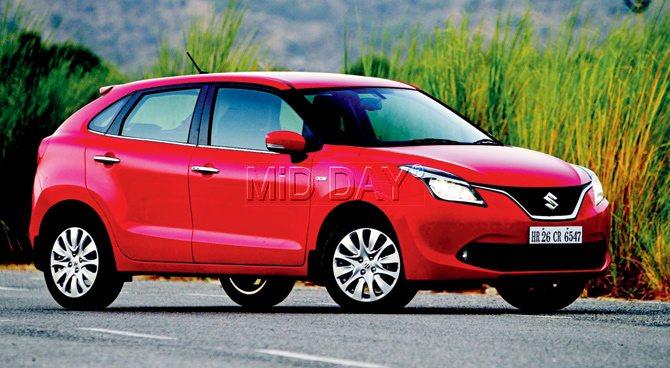The new Baleno is a hatchback, but will it rule the segment?

Maruti-Suzuki Baleno
ADVERTISEMENT
The Indian car market kicked into high gear in 1983, when Maruti launched the Maruti 800. The car was a departure from the Premier Padminis and Ambassadors that had ruled the roost till then. Fast forward to 2005 and MSIL brought the Swift to India, kicking off the premium hatchback segment. The market has been abuzz for a while with spy pics, leaked details and undisguised images of a premium Swift, later confirmed to be the new Baleno. How good is it? We drove the car in Jaipur to find out.

Maruti-Suzuki Baleno
The Baleno launched in 1999 was a sedan; the 2015 Baleno is a hatchback. The “Liquid Flow” design is said to be a synergy of harmony, elegance and energy wave elements. What this translates into is possibly the best-looking hatchback in India. The headlamps do it no favour as they are a near-direct lift from the Swift (though they get projector lamps and LED daytime running lights on top-end variants), but the rest of the design is all-new, including the V-shaped grille. As in the S-Cross, the wing mirrors are mounted on the doors rather than the A-pillars. Sixteen-inch alloy wheels look the right size for this car, though their design could be more attractive. The rear is a neat affair, embellished with LED combination lamps and a chrome garnish. The overall impression is of a classy, sporty look.

The steering wheel, power window buttons and control stalks have come from the Maruti parts bin. Pics/Sanjay Raikar
The interior is reminiscent of other Marutis. Parts such as the steering wheel, power window buttons and control stalks have come from the Maruti parts bin. The quality of plastics could be better, especially on the dashboard and the door pads. A dual-tone interior would have been more appealing than all-black, and the seat fabric is nothing to write home about.
As if to compensate for this, the Baleno is packed to the gills with equipment and features. The instrument panel has twin
dials encasing a 4.2” colour TFT screen that displays a lot of useful information — a clock, average speed, average and instantaneous fuel consumption, a power versus torque meter, and more. Then there’s the centrepiece (literally) of the dashboard — the seven-inch colour touchscreen display that can be split into four quadrants to show, among others, the navigation system, Bluetooth connection with a mobile phone, FM radio, messages and others. Maruti has — for the first time for any car in India — incorporated the Apple CarPlay system (with Siri voice control) in the Baleno, which essentially mirrors your iPhone and allows you to access its functions via the large screen. Android users can connect their phones via the MirrorLink feature and, in addition, there is a USB and an SD card slot.
The front seats are large and comfortable. Better thigh and lower back support would have been welcome, though. The rear seat is particularly brilliant — three average-sized adults sit and, unless you are seven-foot tall, there is a lot of knee-room. Boot space is good, though the access is a little narrow and the loading lip a touch too high.
As with any diesel car, NVH is high; disappointingly so for a premium hatchback. What is great is the near-linear power delivery — yes, more power would have been welcome, but the ubiquitous 1.3-litre FIAT-sourced powerplant provides sufficient go for all the show. Gear ratios are not too tall, and the car picks up speed fast. Suspension is a touch on the softer side, in sync with the requirements of the target segment for this car, and makes for pretty good ride quality over the average rough road. Handling is quite predictable and body-roll is minimal.
Then came the petrol variants. The manual first — it felt quite like the Swift petrol in its responsiveness, and it picks up smoothly and eagerly, allowing some spirited driving. Particularly pleasing is the engine note, especially at higher speeds — there is a sporty snarl that makes you feel you are going faster than you actually are. We next drove the CVT petrol, which marks the début of CVT on a Maruti vehicle in India. As expected, there is a rubber-band effect during acceleration. Sporty drivers might want to give it a miss, but it will work very well for city use and the occasional highway jaunt. In both petrol variants the suspension set-up felt slightly firmer than in the diesel variant, so aberrations in the road surface filter through. The ride quality is still quite good, and there is very little body-roll.
All variants have ABS with EBD, dual airbags, front seatbelt pre-tensioners and force limiters, and a driver seat-belt reminder. The top two variants get front fog-lamps, auto headlamps, and an auto dimming rear-view mirror, and all but the base variant have reverse parking sensors, with the topmost variant also getting a reverse parking camera.
The car looks good and is packed with tons of equipment. The problem is that the competition has had this and more for a while — looks, performance, features, and others. Eventually, it will boil down to the price.
 Subscribe today by clicking the link and stay updated with the latest news!" Click here!
Subscribe today by clicking the link and stay updated with the latest news!" Click here!







